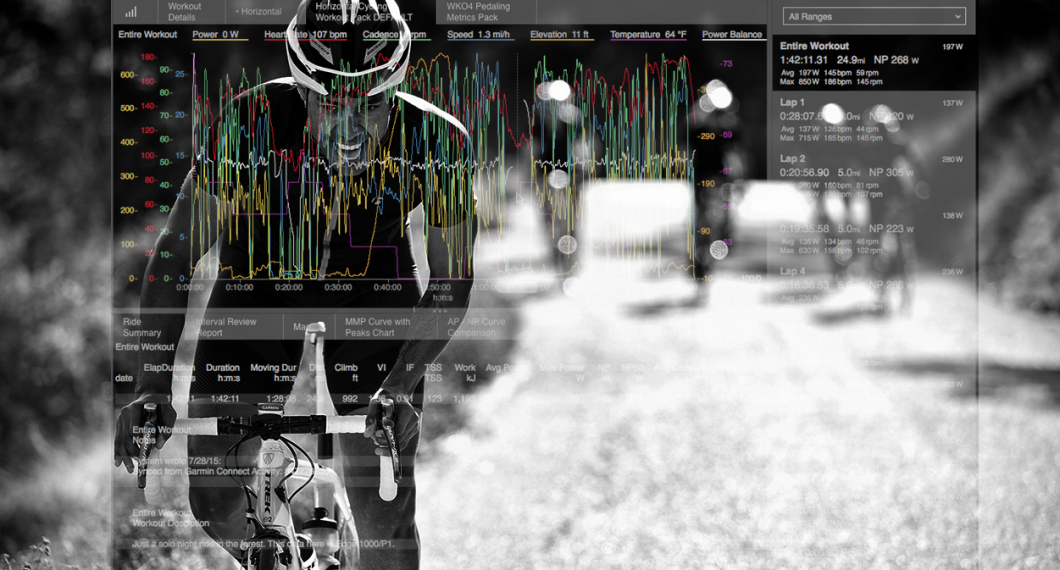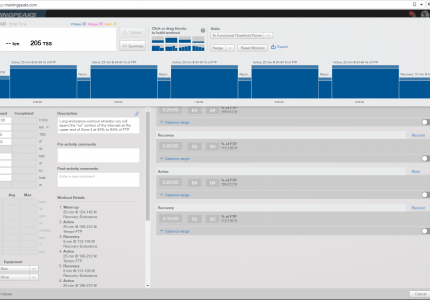If you are going to train with power for cycling then you must develop a power based training plan and apply training prescription utilizing the application of a power training model (PTM). Any training involves exploitation of the dose-response relationship. Whereby you expose the athlete to training dose (load), which is comprised of volume and intensity. The outcomes reflected in changes in performance provide the response and reflect the training affect of the dose over time. Power gives you a means to quantify both these elements.
Overall, the results show that training load quantification methods that integrate individual physiological characteristics have the strongest dose-response relationships, suggesting this to be an essential factor in the quantification of training load in cycling.(1)
Sanders, Dajo & Abt, Grant & Hesselink, Matthijs & Myers, Tony & Akubat,
Ibrahim. (2017).
One of the conclusions of early studies, such as the seminal 1976 Calvert & Banister paper (cite), is that recovery, and training bout frequency and intensity, affected the response and output side of the relationship. However, the relationship between the amount of work performed and the improvement in physical performance achieved appears to be more complex than a simple dose-response effect. Too much training with insufficient recovery between sessions could provide a level of performance lower than expected.
Many studies have shown results which indicate that training load quantification methods that integrate individual physiological characteristics have the strongest dose-response relationships, suggesting this to be an essential factor in the quantification of training load in cycling.
This means training is specific not just to event and discipline, but also to individualized athlete physiology and their characteristics.
Models attempting to quantify the relationship between training and performance have been proposed, many of which consider the athlete as a system in which the training load is the input and performance the system output. Although attractive in concept, the accuracy of these theoretical models has proven poor. A possible reason may be the absence of a measure of individuality in each athlete’s response to training. Thus, in the future more attention should be directed towards measurements that reflect individual capacity to respond or adapt to exercise training rather than an absolute measure of changes in physiological variables that occur with training.
Borresen, J., Lambert, M.I. The Quantification of Training Load, the Training Response and the Effect on Performance. Sports Med 39, 779–795 (2009). https://doi.org/10.2165/11317780-000000000-00000
In addition, a power based training plan must try to factor in secondary and tertiary factors, such as fatigue and recovery rates. This will allow for a specific training plan to utilize periodized workouts and exploit optimal power data variables measuring the resulting physiological and training response.
Within a PTM the physiological responses and expected adaptions of the body correspond to the training stress put on the individual systems and can be described by the training levels or training zones that define effort intensity and duration. Figure 1, below illustrates the typical expected physiological adaptations from training in each of the classic Coggan power training zones.
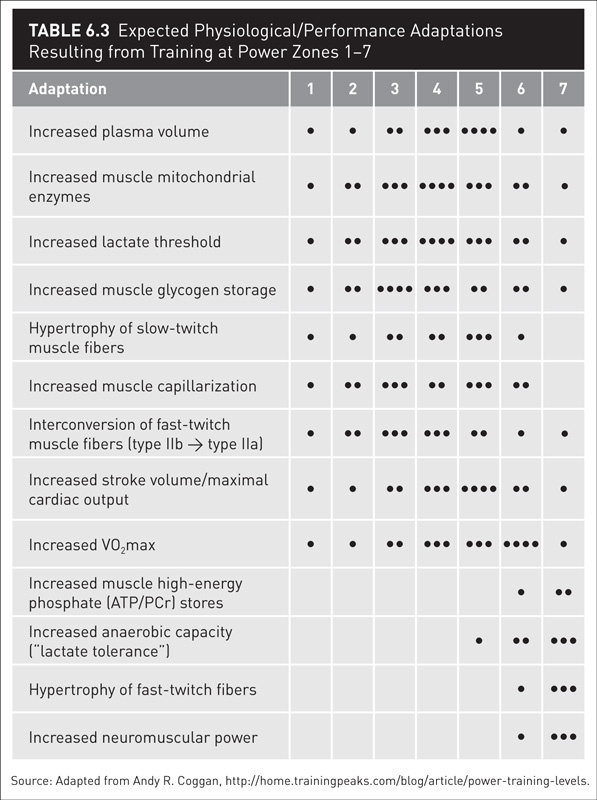
The rationale of training levels (zones) structure
What has typically been referred to as training zones in popular training literature (see above) is in fact simply a means to associate training stress and effort to explicit physiological systems of the human body and to relay that as an effort and time duration relationship. Therefore, the most useful training level structures follow a methodology of mimicking human physiology and attempts to map the performance of the body to innate physiological response over time and intensity domains.
The purpose of power training levels
The use of training levels (zones) is to allow a physiological performance model to be referenced that allows you to measure and modify training dose and response. Zones are descriptive rather than prescriptive. In aerobic pursuits such as cycling and running, a zone or level is a percentage range of threshold power or pace and has a fixed relationship to time duration such that a given amount of time spent exercising at a level will be effective in invoking an impact on a specific physiological system.
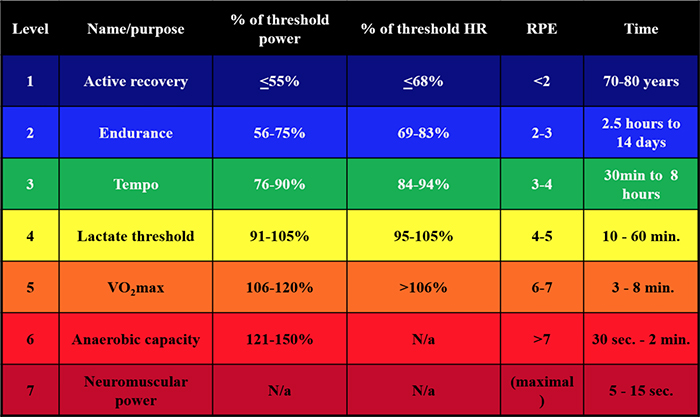
Essentially, training levels are a way of categorizing how intense an effort is, which dictates how long the effort will last and which energetic systems will predominantly supply energy for the effort. Training should stress an energy system enough, such that it is challenging for the system to supply energy for the effort. This creates an ‘adaptive stimulus’ which encourages the body to change and make the same effort easier next time it is attempted.
For training needs, the relationship between time and exhaustion can be divided into four groups according to dominant metabolism, which supplies energy to muscles:
- Neuromuscular Power: 5-15 seconds. The lactate anaerobic metabolism is the basic energy system ensuring motor activity (phosphagen system).
- Anaerobic Capacity Power: 30 seconds to 2 minutes. Motor activity of high intensity is primarily supplied with energy by the anaerobic lactate system (anaerobic glycolysis).
- Vo2Max: 3-8 minutes. From this period on, the aerobic system is dominant, but the portion of anaerobic lactate metabolism can still be large (anaerobic and aerobic glycolysis).
- Steady State/Endurance Power: Approximately 10 minutes to several hours. Motor activity is ensured by the aerobic energy system from more than 90% (oxidative system).
Individualized Power Training Models
Power training models such as the WKO5 Power Duration model provide the framework and protocols for enabling decision making to be made regarding training, adaptation, and individual workouts, with respect to the individual physiological profile of the athlete. Power-Duration models help us understand not only the overall relationship between time and power exhaustion limits but also how to prescribe training plans and workouts to create maximal results and adaptation.
All cyclists have different strengths and weaknesses. When working to improve your training and race or event performance, it is important to correctly identify your strengths and weaknesses and to use this knowledge to design both your short and long term training focus and your race strategy. In the PTM, the power profiling and phenotype identity of an athlete allows for an assessment of current (acute) fitness traits and a reference to how those are developing or changing over time and becoming the chronic or part of an improved longer term fitness profile of the athlete.
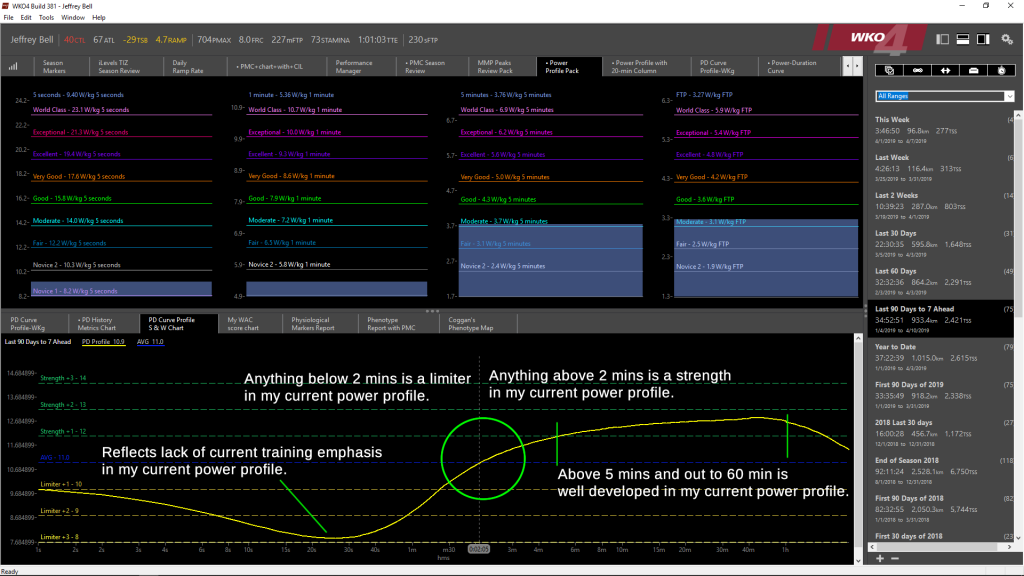
New Concepts and Tools
In the last few years training systems based around alternate measures of maximal and sustainable power, combining individualized applied physiology and energy utilization have emerged, (See Xert ATA and WKO5 iLevels, discussed below). However, the physiological model of human performance is a well established scientific model. Newer approaches are individualizing the application of performance i.e. how the body utilizes energy and converts substrates to fuel and how the demands of athletic effort over time utilize those systems.
The combination of established physiological training models, and the growth of new training models, provides greater ability to interpret how the human physiological system and applied training prescription (coaching is a part of that) are brought together to evoke improved performance and fitness effectively over time. This is the real area of debate, discussion and learning.
The most common types of power based cycling training models are based on concepts of threshold (aerobic and anaerobic) and incorporate intensity, frequency and duration (dose), as the inputs, with stress, fatigue, and performance, as the main output or training affect measurements.
Coggan – Power Duration Model
Many power based cycling training models also include a base of scientific and mathematical modelling (cite 1., cite 2.) such that they are verifiable by testing. That is, from measuring and recording athlete data and through mathematical principles that allow for a minimum level of certainty in the hypothesis of the model. One of the leading examples of this is the derivation and scientific basis of the Power Duration Model (PDM) developed by Dr. Andy Coggan (link below).
https://www.trainingpeaks.com/blog/scientific-basis-of-the-new-power-duration-modelin-
wko4/
XERT – Adaptive Training
Xert has ushered in some revolutionary ideas and innovations in measuring fitness, how much power you have available at any moment, which energy systems you use as well as highlighting how traditional methods miss key training variables like strain and focus. The Xert Adaptive Training Advisor (XATA) is a smart training recommendation engine that factors in many variables obtained from analysis of your power data.
Xert brings all these concepts together and uses them to improve the workouts that are prescribed and completed, they call them Smart Workouts. Rather than using zones and simple duration-based intervals, Smart Workouts are based on strain and the power you can generate at any given point in time. Workouts are precisely tuned to your ability in a much more dynamic time domain.
WKO5 Individualized Training Model
The mismatch of physiological response and time and intensity relationships among individual athletes tend to arise at higher intensity levels. Those levels above steady state and anaerobic thresholds (AT) or FTP, whereby some individuals do not follow the bell curve of descriptive physiological response that the original Coggan training levels model was based off.
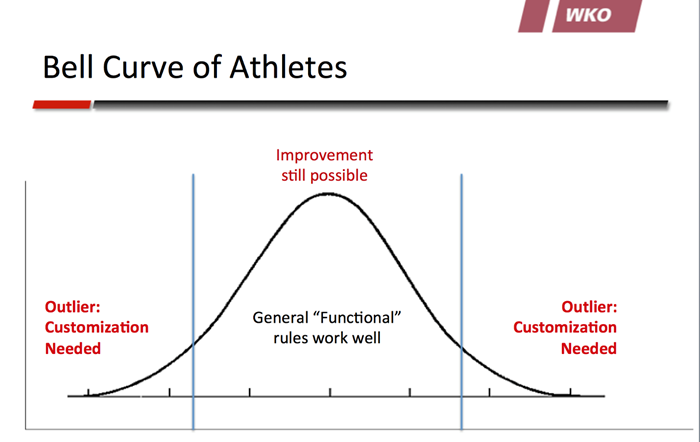
customized training levels.
When an athlete is training at intensities above functional threshold power (FTP) or intrinsically beyond steady state intensities, the relationship of physiological intensity to the FTP reference begins to be a lot more individualized for the athlete. The neuromuscular maximal, anaerobic and maximal aerobic intensities above FTP, that relate to the concepts of PMAX, Functional Reserve capacity (FRC) and VO2Max begin to track on a more individualized time-duration domain. WKO5 refers to ilevels to represent training zones in this intensity range above FTP.
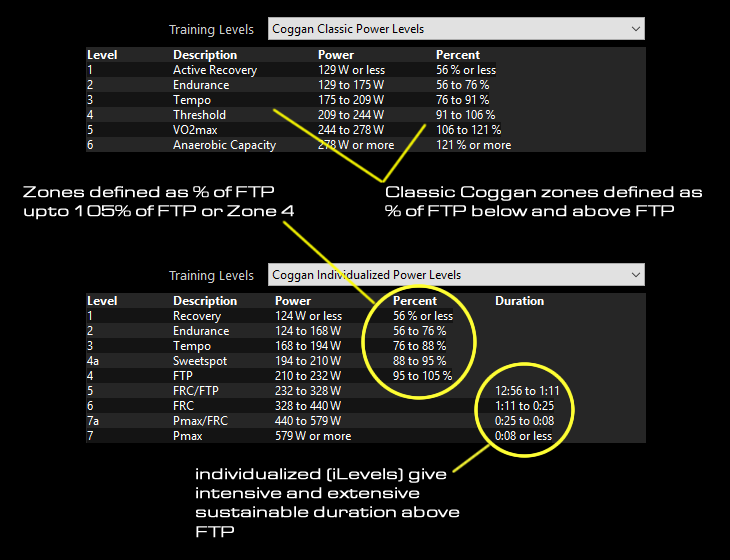
Any physiological benchmark such as FTP, Critical Power, and MLSS are established with direct measurement and estimation protocols published widely. Again, the most important discussion is how these physiological performance markers are leveraged for an athlete to produce the most effective results with training programs based on the various power based training models (PTMs) that can be used.
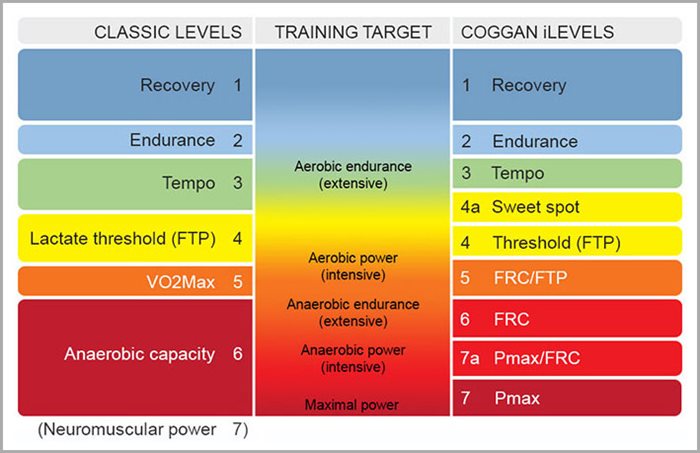
One of the new features found in the WKO5 software is an extensively-tested and rigorously-validated mathematical model of the maximal exercise intensity (power, in the case of cycling) versus duration relationship. This is the Power Duration Model represented by the PDC or power duration curve. The PDC is fed by the Mean Maximal Power (MMP) data of an athlete and is a symbiotic system.
A number of software packages including platforms like Strava and Zwift produce a MMP power curve and an associated derived power curve. The raw MMP data will be more stochastic and will tend to plot around the modeled data of the PDC such as in Figure 6 below.
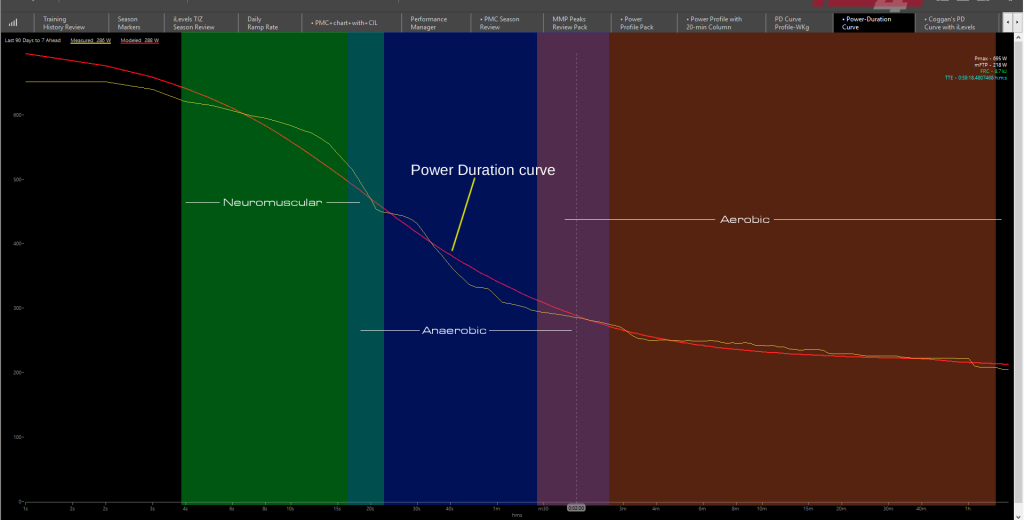
How to build training plans and workouts with training levels
As training levels (zones) map effectively to physiological systems and their exercise response patterns, the coach or athlete should have an understanding of the cyclical progression of fitness within the demands of their sport or activity over periodic intervals from days, to weeks, to seasons and years in order to construct an effective training plan.
In this way training plan creation and execution becomes an exercise in estimating and identifying how much stress and training volume a particular athlete can effectively utilize for the greatest training adaptations and benefit, and when to balance that stress with bouts of recovery and supplementary aspects such as skill development. This is a constant challenge, that the coach or athlete needs to figure out.
Once successfully established a power based training plan will allow for better management of the resources and training time throughout the training year.
At what time in a training cycle the athlete should put emphasis on or develop a particular physiological facet, such as aerobic endurance, or neuromuscular peak force will be determined by an understanding of the demands of their discipline, the demands of individual competition, and the dates of the race or target events in the calendar. Such knowledge comes with experience and time but physiological adaptation and performance parameters have a relationship that is quite clear. Table 6.3 below outlines these.
Conduct an initial assessment
The first step to using a PTM is to identify the athlete’s physiological and psychological makeup. This is done in the pre-planning phase is to understand where you or the athlete you’re working with is starting from to the greatest extent possible. At this point in the process, we’re looking to understand more than just performance data such as thresholds, economy/efficiency or peak power; we want to have a complete picture of all of the factors that contribute to and may therefore limit training ability and performance potential.
Some of these factors include:
- Work and family life
- Training history
- Nutritional practices
- Sleep quality
- Psychological strengths and weaknesses
- Strength and mobility
- General health
- And of course, physiological data and recent test results
Gathering this data typically takes the form of an assessment, whether this is face-to-face discussion with an athlete and/or completing a detailed questionnaire to glean all of the key information required to understand the athlete’s entire training-related environment.
An important part of identifying the physiological profile of the athlete is to get a clear idea of what attributes they possess in relation to power output and system development. These can be couched as strengths and weaknesses but more fairly relate to what is needed to be trained as it relates specifically to the athlete’s competitive domain or pursuits.
In cycling some of the most common training realms are that of say a long course triathlete or time-trial specialist and a criterium racer or short course mountain bike racer. There are some common developmental facets to all of these, but when it comes time to hone the athlete’s performance as they become more competitive or specialized or at a competitive point in the training year, then a criterium racer is not going to have the emphasis that a long-course triathlete has or again even that of a track specialist or hill climb focused athlete.
References:
- Distribution of Power Output During Cycling – Impact and Mechanisms; Sport Medicine; Greg Atkinson, Oliver Peacock, Alan St Clair Gibson, Ross Tucker (2007), https://link.springer.com/article/10.2165/00007256-200737080-00001
- Knowledge is power: Issues of measuring training and performance in cycling, L. Passfield, JG. Hopker, S. Jobson, D. Friel & M. Zabala (2017), Journal of Sports Sciences, 35:14, 1426-1434, DOI: 10.1080/02640414.2016.1215504
- Rationale and resources for teaching the mathematical modeling of athletic training and performance. David C. Clarke and Philip F. Skiba. 1 Department of Biological Engineering, Massachusetts Institute of Technology, Cambridge, Massachusetts; and College of Life and Environmental Sciences, University of Exeter, Exeter, United Kingdom, (2013).
- Monitoring the training process in competitive road cyclists. A critical evaluation of intensity and load measures and their ability to inform the training process; Dajo Sanders, PhD. thesis, Liverpool Hope University
- Applying the Numbers Part 3: Training Stress Balance, Joe Friel, July 3, 2015,
- How to Target the Best Power and Adaptation Using Optimized Intervals, Tim Cusick, December 12th, 2016, https://www.trainingpeaks.com/blog/how-to-target-the-bestpower-and-adaptation-using-optimized-intervals/
- The Quantification of Training Load, the Training Response and the Effect on Performance, Borresen, J. & Lambert, M.I. Sports Med (2009) 39: 779. https://doi.org/10.2165/11317780-000000000-00000
- A systems model of training for athletic performance, Banister, E. W., T. W. Calvert, M. V. Savage, and T. Bach. Aust. J. Sports Med. 7: 57–61, 1975.
- Methods of Monitoring Training Load and Their Relationships to Changes in Fitness and Performance in Competitive Road Cyclists. Sanders, Dajo & Abt, Grant & Hesselink, Matthijs & Myers, Tony & Akubat, Ibrahim. (2017). International journal of sports physiology and performance. 12. 10.1123/IJSPP.2016-0454.

